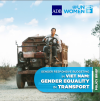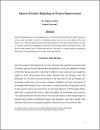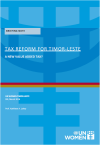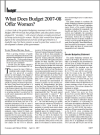FOUND 17 RESULTS
Drawing on international examples, and in consultation with the Viet Nam Ministry of Transport officials, this paper highlights the importance of a gender responsive budgeting (GRB) approach and explores how to implement it in the transport sector in Viet Nam.
Well-being gender budgeting (WBGB) experiences use a multidimensional approach for planning and budgeting combining the Capability Approach along with gender responsive budgeting. However, what happens to the other well-being budgeting initiatives that do not explicitly include this «gender focus» in their conceptualization? This article explores the gender biases that can be found in well-being budgeting and the challenges of integrating a gender perspective into these practices. It...
This paper is an attempt to measure the effectiveness of Gender Budgeting as a tool for women empowerment. In recent years, Gender Budget Initiatives have emerged as an effective way to bridge gender gaps. First step towards this goal was taken by Australia, South Africa and Philippines followed by other developed and less developed countries including India.
The GRBC has developed five criteria for evaluation of genderresponsiveness of the budgeted government programmes and projects. These criteria include women's participation in programme formulation and implementation, benefit accruing to them, their capacity building, contribution to women's employment/income generation, and reduction in women's workload and qualitative improvement in their time use.
Governments raise tax revenues so that they can meet the needs of the people they represent. Fair and equal taxation makes sure that tax laws do not discriminate against people who live traditional lives, subsistence farmers, rural business owners, women, or the poor
The document provides a gender analysis of the Australian Treasurer's 2006/2007 budgetary changes by examining the gender impacts of newly introduced tax concessions. It identifies the groups most able to take advantage of these as being income and flexible-asset rich Australians (which include relatively few women).The paper concludes by identifying the elements of a budgetary approach that would contribute to a more female- friendly retirement incomes policy.
This article takes a closer look at the gender budgeting statement in the Union Budget 2007-08 in India and reveals that programmes and allocations remain plagued by mistakes, with several schemes wrongly prioritised as being exclusively for women. Economic and Political Weekly April 21, 2007






